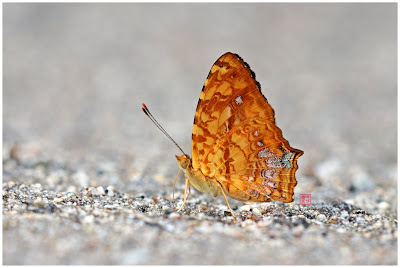The Malayan Jester (Symbrenthia hippoclus selangorana)
A Malayan Jester puddling at a sandy trail in the nature reserves
Another year has almost gone by, and we are on the threshold of the 11th month of 2021. There is light at the end of the tunnel and many countries are reaching a tipping point as far as managing COVID19 is concerned. At least for most of us, the light at the end of the tunnel is not the headlamps of an oncoming locomotive! There is some optimism although local statistics tend to be biased towards just putting the pandemic unnecessarily in a negative limelight.
Friends who have managed to travel overseas, out of necessity for work or other personal reasons, have shared their experiences in different countries. The management measures range from "living as though Covid is over" to "continued strict quarantine regime" in different countries. Each government has its own prerogative to manage things the way they deem fit - treating the virus as endemic and opening up liberally where people go about their daily life even without masks, to a zero case strategy where snap lockdowns are imposed the moment there is even a slightest evidence of a potential resurgence of infections.
But the world is moving slowly but surely towards a normalcy that has been redefined by COVID19. A new world where the virus will be treated like the myriad of diseases, whether life-threatening or otherwise, that we humans have to live with. For many of us, we wait in anticipation of being able to travel overseas again. Whilst we always appreciate being home, too much of a good thing may also cause us to wonder what it is like to get out and learn new things as we have done so in the past.
For us butterflyers, it has been nearly two years of being locked down without any overseas trips. Perhaps this is why the social media has had a higher number of sightings of the less often-seen local species? There are more "eyes and ears" on the ground than would have been normally the case. Also, the cross-over shooters from the bird watchers have also been active with their long lenses, and have been able to spot more species from afar, that would have usually been out of reach of the macro shooters.
A conversation with some friends likened the travel restrictions and lock downs to a Rip Van Winkle effect. Where we wake up after a period of time, and wonder how things have changed and we are just catching up for lost time. Would we have been more efficient and productive, and had experienced a lot more new things if not for these two years "stolen" from us? I doubt if anyone was measuring or tracking the loss of productivity in most cases. Nor would anyone admit to it. Will 2022 see major changes? Let's hope so!
Our Butterfly of the Month for October 2021 is the Malayan Jester (Symbrenthia hippoclus selangorana). When it was first spotted in 2012, it was the first time a species of this genus was discovered in Singapore. Recorded as a new discovery, it is considered a non-native species in the Singapore checklist. Although the species is not rare in Malaysia, it is classified as an exotic species under the IUCN definition as far as Singapore is concerned.
After that first observation, the species was not spotted again until some years later, when a colony of them was found at the Dairy Farm Nature Park. Several individuals, some very pristine, were observed over a period of a few weeks. The individuals were puddling or sunbathing along the main trail at the nature park, and on some occasions, a few individuals were encountered together.
The species continued to be observed at various parts of Singapore, indicating that it had spread to other locations. Recently, a caterpillar of this species was discovered feeding on the leaves of the Australian Mulberry (Pipturus argentus). This is also the host plant of another local butterfly species - the Malayan Eggfly (Hypolimnas anomala anomala), which is also under the same subfamily Nymphalinae as the Malayan Jester.
A Malayan Jester puddling at a damp footpath at Dairy Farm Nature Park
The Malayan Jester is black with orange bands on the upperside, arranged horizontally across both wings. There is a short stubby tail on the hindwing. It is a medium sized species with a wingspan of about 45mm. There are several lookalike species in the genus, and may be difficult to identify from the upperside markings alone.
A sunbathing Malayan Jester peers down from its lofty perch
The underside is pale orange-brown and richly variegated, giving a marbled appearance. The Malayan Jester is often confused with a nearly lookalike species the Common Jester (Symbrenthia lilaea luciana) but can generally be distinguished from that species by the discal spot in space 3 of the underside of the forewing - where it is orange in S. lilaea but outwardly pale pinkish or nearly all pinkish in S. hipplocus. Also, contemporary literature also indicates that S. lilaea is a montane species that is usually found in the hills above 1,000m.
The Malayan Jester is fast on the wing and skittish, but may be approached when it is feeding on flowering plants or puddling on damp forest footpaths. The caterpillar of the Malayan Jester has been successfully bred on Australian Mulberry (Pipturus argenteus) Urticaceae in Singapore.
Text by Khew SK : Photos by David Chan, Federick Ho, Khew SK, Koh CH and Lim HP














2 comments:
Please know that the correct spelling is Pipturus argentEus.
Keith
Thanks for the correction, Keith. :)
Post a Comment